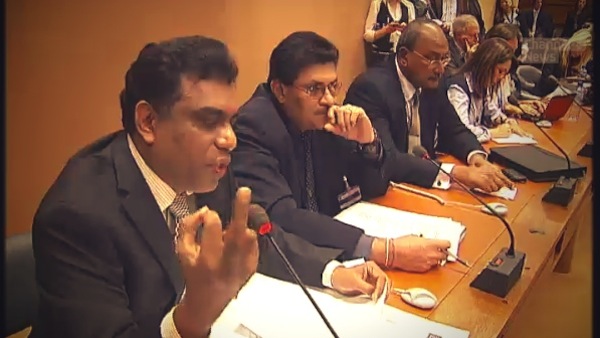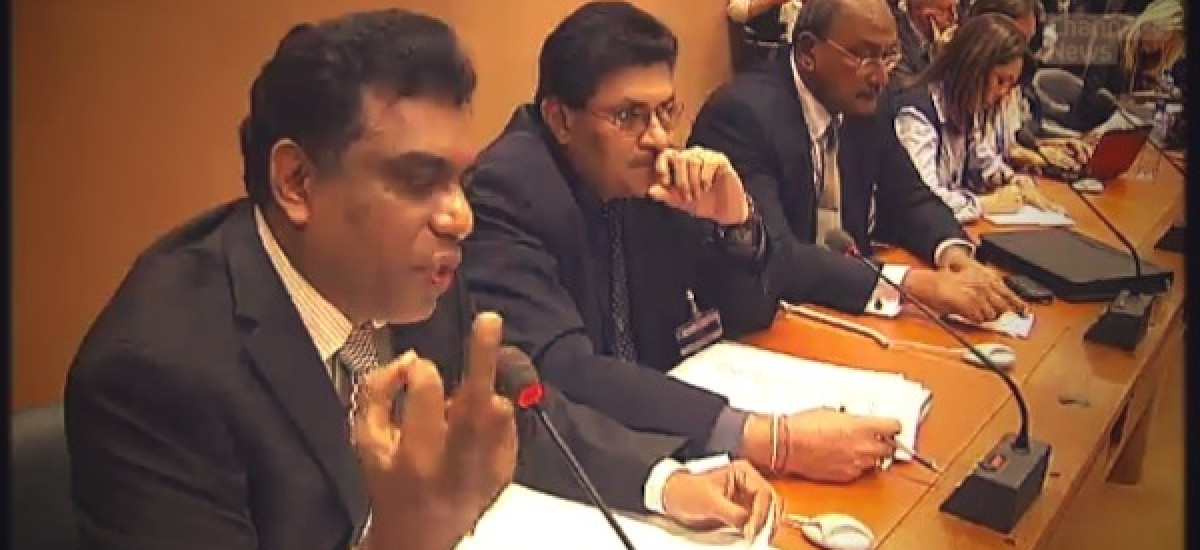
Mr. A Nawan, Deputy Solicitor General of Sri Lanka
This symbolic screen grab is from a short video on Channel 4’s website, on the occasion of screening in Geneva a one-hour documentary into the denouement of the war in Sri Lanka. As Channel 4’s website notes,
“Disturbing footage in the film includes the apparent extra-judicial massacre of prisoners by government forces, the aftermath of targeted shelling of civilian hospitals and the bodies of female Tamil fighters who appear to have been sexually assaulted. Also examined in the film are atrocities carried out by the Tamil Tigers, including the use of human shields, and footage depicting the aftermath of a suicide bombing in a government centre for the displaced.”
The Deputy Solicitor General of Sri Lanka notes in response to the screening of the documentary,
“We have already made a preliminary investigation on the video and we have scientific material established that this particular video is not authentic.”
Clearly he knows something our Attorney General Mohan Pieris does not. Just days before, speaking to the same gathering of people in Geneva, our Attorney General noted,
“…the Government had been precluded from making a full assessment of the Channel 4 video because of the blurred quality of the images”
This fiasco again captures so well the Sri Lankan government’s deranged diplomatic and domestic responses to serious war crimes allegations. Our Foreign Minister contradicts himself daily and as we have carefully documented has no coherent response to the UN Panel’s report. Worse, he seemingly lies in and misdirects parliament. The government organised seminar on how to defeat terrorism, but didn’t address serious human rights concerns captured most recently by the UN as well as in the explosive book by former UN spokesperson Gordon Weiss, The Cage. Plus there is the no civilians killed party line. Finally, there are even those who believe that even if the Channel 4 video is true, it is “unrepresentative and irrelevant”.
We didn’t in fact publish the video Channel 4 first broadcast it in 2009. It was too gruesome for a start. The shock factor for British and foreign audiences would have been tasteless and counterproductive to feature on a site read mostly by those who are no strangers to violent conflict. Secondly, it was when first broadcast, by Channel 4’s own admission, unauthenticated video. While Channel 4 and Journalists for Democracy may have had good reason to believe the video was true, we had no way of ascertaining this since no one else had seen or examined it. We did however have some extremely interesting debate and discussion around the video at the time. A video of shame and outrage: Responses, positions and clarifications captured some of the best comments. At the time, because Channel 4 said that they could not verify the authenticity of the video, many commentators like Observer parroted the line of the Sri Lankan government as well the High Commissioner in London, calling the video “an unbelievable fabrication”.
The government hasn’t changed its tack, but the video continues to haunt it. It refuses to go away because in 2010 and again this year, under two consecutive UN Special Rapporteur’s on extrajudicial, summary or arbitrary execution, the authenticity of the video has been established. In 2010, Philip Alston’s investigation held the video was authentic. In 2011, the investigation into the longer version of the video by Professor Christof Heyns concurred. Back in 2009, the government tried and failed to convince OFCOM to take action against Channel 4 for broadcasting this video. Human Rights and Disaster Management Minister Mahinda Samarasinghe said in September of that year that the Government would call for the retraction of video from Channel 4, as comprehensive investigations and analysis conducted by four experts commissioned by the government had provided scientific evidence to prove that it was a fake and a heavily tampered video. Minister Samarasinghe also said legal action against Channel 4 was being considered.
Is this the scientific evidence being quoted now by the Deputy Solicitor General of Sri Lanka? But if the Attorney General is to be believed that the video is too blurred to assess accurately, what then of this ‘scientific evidence’? What happened to the legal action against Channel 4? Where are the government experts, two in fact from the Sri Lankan army, today?
The government’s response (or more accurately, conflicting responses), much like the Deputy Solicitor General’s involuntary yet hugely symbolic gesture, is sadly very far removed from what even some of its most senior diplomats suggest is a better way forward. Truth, it seems, is not just a casualty of war, but remains hostage to our government’s notion of peace.

